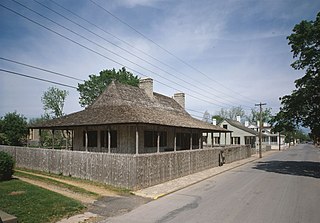Common Field Archeological Site | |
 | |
| Nearest city | Ste. Genevieve, Missouri |
|---|---|
| NRHP reference # | 69000306 [1] |
| Added to NRHP | July 29, 1969 |
The Common Field Archaeological Site, designated by the Smithsonian trinomial 23-SG-100, is a prehistoric archaeological site near Ste. Genevieve, Missouri. Located in the bottom lands along the Mississippi River, it encompasses the remains of a Native American platform mound. The site is named after its location in the "common fields", an area of farmland laid out by French colonial settlers in narrow strips of land for cultivation. [2]
Smithsonian trinomials are unique identifiers assigned to archaeological sites in many states in the United States. They are composed of one or two digits coding for the state, typically two letters coding for the county or county-equivalent within the state, and one or more sequential digits representing the order in which the site was listed in that county. The Smithsonian Institution developed the site number system in the 1930s and 1940s. The 48 states then in the union were assigned numbers in alphabetical order. Alaska was assigned number 49 and Hawaii was assigned number 50 after those states were admitted to the union. There are no Smithsonian trinomial numbers assigned for the District of Columbia or any United States territories.

Ste. Genevieve is a city in Ste. Genevieve Township and is the county seat of Ste. Genevieve County, Missouri, United States. The population was 4,410 at the 2010 census. Founded in 1735 by French Canadian colonists and settlers from east of the river, it was the first organized European settlement west of the Mississippi River in present-day Missouri.

The Mississippi River is the second-longest river and chief river of the second-largest drainage system on the North American continent, second only to the Hudson Bay drainage system. Its source is Lake Itasca in northern Minnesota and it flows generally south for 2,320 miles (3,730 km) to the Mississippi River Delta in the Gulf of Mexico. With its many tributaries, the Mississippi's watershed drains all or parts of 32 U.S. states and two Canadian provinces between the Rocky and Appalachian mountains. The main stem is entirely within the United States; the total drainage basin is 1,151,000 sq mi (2,980,000 km2), of which only about one percent is in Canada. The Mississippi ranks as the fourth-longest and fifteenth-largest river by discharge in the world. The river either borders or passes through the states of Minnesota, Wisconsin, Iowa, Illinois, Missouri, Kentucky, Tennessee, Arkansas, Mississippi, and Louisiana.
The site was listed on the National Register of Historic Places in 1969. [1]

The National Register of Historic Places (NRHP) is the United States federal government's official list of districts, sites, buildings, structures, and objects deemed worthy of preservation for their historical significance. A property listed in the National Register, or located within a National Register Historic District, may qualify for tax incentives derived from the total value of expenses incurred preserving the property.
















